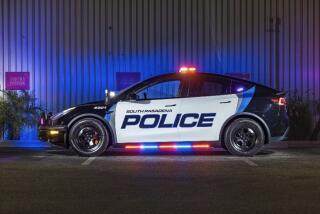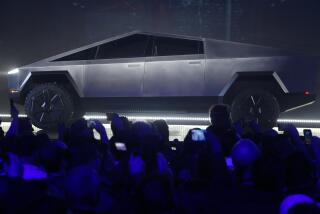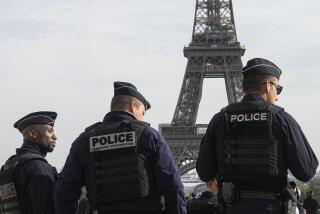Bright idea makes police beam
It had to be powerfully bright, easy to operate and -- perhaps most importantly -- too small and light to be used as a dangerous weapon that could embarrass the Los Angeles Police Department and cost the city significant financial damages.
The result: The 7060 LED, what some consider to be the police world’s most innovative -- and least harmful -- flashlight.
The product has drawn the interest of police agencies across the country, as some have inquired about buying the smaller flashlights -- for about $100 each -- for their officers.
And the flashlight’s unveiling, which is scheduled today at police headquarters, is drawing top LAPD officials, including Chief William J. Bratton, as well as accolades from critics.
“It’s a really important step in the right direction, and it’s going to make a difference in how the Police Department deals with the community,” said Ramona Ripston, executive director of the American Civil Liberties Union of Southern California. “We’ve always felt that a flashlight was not an instrument to beat people with. This new one will serve the purpose it was intended to.”
More than two years in the making, the 7060 LED was born as a concept in the days after the high-profile beating of Stanley Miller by LAPD officers. The car-theft suspect had been chased to a Compton creek bed in June 2004. News footage that was shot from a helicopter and broadcast worldwide showed an officer striking Miller 11 times with his 2-pound, 2-foot-long flashlight.
Immediately after the beating, Bratton banned the large, metal flashlights, which until then had not been prohibited by the department as tactical weapons. Since 2002, at least 57 incidents in which police officers wielded flashlights as weapons against suspects had been reported.
But banning the flashlights created another problem: What would officers use on the street, where dime-store plastic torches normally tucked into nightstands in case of blackouts would be inadequate?
In November 2005, the LAPD asked manufacturers to create a flashlight like none other.
It could be no longer than 10 inches and could weigh no more than 12 ounces. It needed to provide the powerful illumination of a huge flashlight and be extra durable. And patrol officers wanted a special feature: a dual switch that would allow them to temporarily blind a suspect no matter how the flashlight was held.
At an early meeting, one potential bidder bowed out, telling representatives from the ultimate winner, Pelican Products, “Good luck.”
The use of flashlights as weapons has long vexed law enforcement agencies.
More than two decades ago, a study in the Journal of Police Science and Administration warned that flashlights caused more suspect injuries than police batons.
When he banned the big flashlights, Bratton promised to find a substitute that would meet officers’ safety needs while eliminating the potential for misuse.
The challenge tempted companies that saw a lucrative LAPD contract as well as the possibility of a much larger market. LAPD Cmdr. Terry Hara was put in charge of seeking bids to design and make the flashlights. More than a half-dozen companies jumped at the chance to design the lights.
But numerous hurdles proved too difficult for many of the competitors.
Hara said the specifications alone were enough to drive many vendors out. Some said a 10-inch flashlight as bright as a big flashlight could not be made.
Many questioned whether the flashlight could be built without violating the patents of other makers. Most decided simply to present existing models as their prototypes.
At the same time, the Los Angeles Police Protective League questioned whether the smaller flashlight would make street officers more vulnerable.
Union officials openly doubted whether smaller lights could provide as much illumination at crimes scenes as bigger ones.
“We knew we were pushing the envelope,” Hara said.
After a few months, only one company was left: Pelican, which is best known for making ocean diving equipment, including waterproof flashlights.
Pelican set out to produce prototypes of the light. Its project leader drove several times a week from the firm’s Torrance plant to Parker Center to display the latest designs.
They first tackled illumination. Large, off-the-shelf flashlights provide about 120 lumens of light, which is significantly brighter than an outdoor floodlight.
Most current “mini-lights” give off about 30 lumens, which is equivalent to the brightness of a reading light.
Pelican engineers considered a design with xenon-type bulbs before settling on LED technology, essentially a semiconductor that emits light.
Such lights are typically found on backlighting for watches or as numerals on digital clocks and other home appliances.
“They really liked the LED but understood that type of brightness compared to the xenon bulb was not commercially available,” said Chris James, a Pelican manager.
The company devised a unique technology that manipulated and strengthened the light beam by using the mirror cone reflector that surrounded the LED. The design gave off significantly more light than even the brightest normal flashlights.
Another challenge the firm had to resolve was the LAPD’s desire for a feature that would allow officers to quickly change from patrol to tactical mode. On patrol they could switch the light on or off like a conventional flashlight. But when confronting a suspect or searching a building, they could use a button on the rear of the flashlight to flick it on.
Last April, the first prototypes were given to about 30 detectives and patrol officers for testing that lasted about two months.
In the field, officers subjected the lights to such abuses as driving over them, leaving them out on cold nights and dunking them in water. Company officials said they heard that a police dog had chewed on one while playing fetch with it.
Officers generally liked the flashlight but suggested modifications. Pelican dispensed with the rubber grip, which was replaced with a knurled grip pattern like that on a hand grenade. And they gave officers a beam that let them not only temporarily blind a suspect but illuminate a dark room or shoot light on a far-away object.
Some skeptics from other agencies said they were won over.
“I was really impressed. It throws light far, and it also throws it wide,” said Ron Chu of the Los Angeles County Sheriff’s Department Search and Rescue Team, who at first doubted that the small device would measure up.
“It’s the best new flashlight I’ve seen in the last five years.”
*
Times staff writer Megan Garvey contributed to this report.
More to Read
Sign up for Essential California
The most important California stories and recommendations in your inbox every morning.
You may occasionally receive promotional content from the Los Angeles Times.










